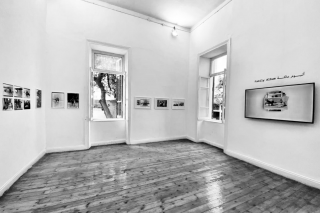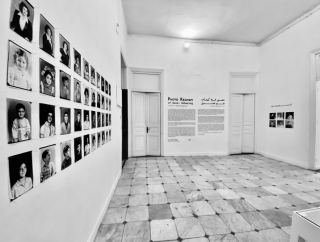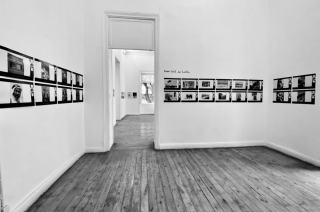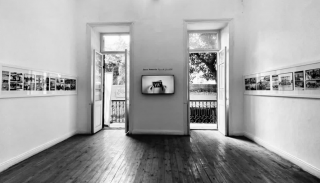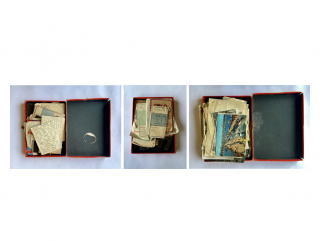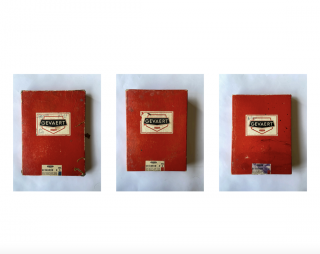Photography faculty Kegham Djeghalian Curates exhibition in Cairo
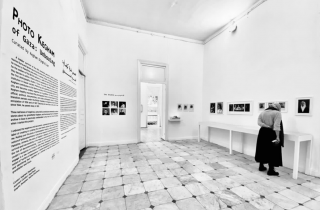
Rediscovered Photos of Gaza reveal a lesser-known side of its history. In the 1940s, photographer Kegham Djeghalian opened the first photo studio in Gaza City. His images show life in the city before it was transformed by war. This exhibition addresses a fraction of the photographic legacy of Kegham Djeghalian Senior, the first photographer of Gaza, as seen by his grandson who engages in archival research to explore Kegham, the person and the photographer, and through both, to explore the visual history of Gaza.
A toddler survivor of the 1915 Armenian genocide, Kegham Djeghalian reaches Syria and grows up across the cities of the Levant. When he comes of age he moves to Palestine and works in a series of jobs, including a tattoo practice for the soldiers of the British battalion. In Jaffa he marries Zevart Nakashian and they decide to settle in Gaza, where he establishes his “Photo Kegham” in 1944, the first photography studio in Gaza. The studio gradually evolves into a key institution in Gazan society. Mentoring and supporting young photographers, Kegham contributes to the democratization of the photographic practice in the city and becomes widely regarded as its godfather. For almost four decades Kegham steadily inscribed the photographic history of Gaza through his social, official, political, documentary, and studio photography during its turbulent transition periods under the British mandate, the Egyptian rule, and the Israeli occupation of 1956 and of 1967. Declining to leave Gaza at any point in time since 1944, he passed away in 1981.
Three red boxes of negatives, some family-owned photo memorabilia, scattered stories about my grandfather Kegham, and the knowledge that his photographic archive in Gaza is practically unattainable to me, that is all I had of his legacy when I started this project. I unboxed the negatives and documents, scanned and examined them, but the labor of creating or curating this small family archive still seemed colossal to me. Mulling over this body of photographic material, I came to realize that the notion of ‘a disrupted history’ is key to my research; the disrupted history of Gaza, Palestine, Armenia, the story of Kegham’s diaspora, and finally the precarious survival and inaccessibility of his negatives and photographic archive. Running the risk of decontextualizing, I chose to give up trying to identify people I couldn’t recognize or trying to date these photographs.
Instead, I opted to engage in a raw confrontation with the photographs by adopting Foucault’s notion of “plane of emergence.” I started inhabiting the photographic visuals and identifying their signifiers as a method to read the stories of both my grandfather and Gaza.
This kind of “disruptive” reading generates a genuine ambiguity that is fruitful, though unsettling for the work. I embraced this ambiguity in order to articulate the affective and the nostalgic, but also to acknowledge the disrupted narratives and contexts of Kegham’s story and his photos, all of which might seem to paradoxically function as an anti-archival practice. This is demonstrated in the deliberate absence of captions, descriptions, or dates on the displayed work, except for one section in the installation of the exhibition.
The displayed body of work is divided into 4 thematics; the first two attempt to map out Kegham’s professional practice and his socio-political engagement as unveiled by the three boxes of negatives I have at hand. The third is a nostalgic indulgence in his (my) family’s story, which also serves as a kind of reading Gaza’s socio-geographic reality in mid 20th century. The fourth thematic displays some of Kegham’s key photographs mediated through a ‘Zoom Call’ between Cairo and Gaza, an exchange which also served to expose the complex problematics in accessing his archival work in Gaza; another facet of a disrupted history.
This exhibition is a first, and perhaps naïve, confrontation with a “disrupted archive;” a representation of the work in typology rather than chronology, where historiography becomes secondary, yet inherently alluded to through the subjects, objects, and spaces shown in the photographic material. The focus of this research is on Kegham, the person, and his practice as a photographer, through both it becomes a non-linear reading of Gaza. A work in progress, this exhibition is by no means a comprehensive study or presentation of Kegham the photographer of Gaza, but just a preliminary expression of confronting a decimal of his body of work.
In memory of Kegham Djeghalian Senior and in dedication to my family.
Kegham Djeghalian
Curator: Kegham Djeghalian
Assistant curator: Alyaa Rady
Graphic designer: Salma Elkafrway
